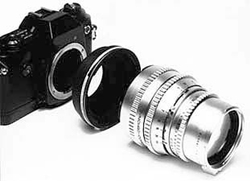I received a phone call the other day from a retired gentleman who was looking at his Mamiya 6×45 medium format film camera system and wondering where to go next.
During the course of our conversation, it came out that he had been very keen, but had not done any serious photography for 10 years. However, now, with some spare time on his hands, he was looking at getting back into it, and of course a 6×45 film camera just isn’t practical these days.
He was interested in going digital, but wondered where he could go to learn how to use these new-fangled digital things. He had his eye on a Canon D5, and also wondered if he could use his Mamiya prime lenses on the Canon. That of course was a difficult question to answer, as it would need adaptors, and more than likely, the Auto-Focus system would not work (but the manual focus should) and the aperture might need to be manually selected.
 Medium format lens and a 35 mm camera.
Medium format lens and a 35 mm camera.
As far as adaptors were concerned, after a brief internet search it was apparent that there were many, including shift-lens adaptors, a useful piece of equipment to have. Most of these were available through eBay, so that would be a good cheap source.
The internet posts confirmed that you must go to manual focusing when using the Mamiya lenses on the Canon body, and aperture priority may need to be used.
There was some discussion as to whether the medium format Mamiya lenses were as good as the new 35 mm lenses for the digitals, and the jury seemed to be split on that.
However, one poster got it right when he said it was just a joy to use the big manual controls, and forget the modern plastic AF lenses and just slow down and enjoy the basic mechanics and rituals of manual photography. Also there is no vignetting that there can be with 35 mm lenses, and no color fringing either.
When you look at the situation of using the medium format lenses on the 35 D body, it seems like a win-win situation all round. Now while our reader was using his Mamiya 6×45, to check exposure and sharpness he would have had to use a Polaroid back to get an ‘instant’ (one minute) check on the variables. Exposure not quite right? Another Polaroid, and so it would go on, until it became quite expensive and time consuming. I also found it very difficult to judge sharpness on a Polaroid, as the images were always slightly fuzzy.
Now with the technology that comes with a digital body, you truly do get an instant check on exposure, and by enlarging the image on the LCD you can soon see if the focus is correct.
When I look at the reader’s situation, he has the experience of how to use a medium format camera, so understands exposure variables. He has plenty of ability to be able to handle the Canon D5, and all he has to do is set the camera body on ‘manual’ and not worry about the drop-down menus at all. The Owner’s Manual will show anyone how to set the camera body on manual, and he can actually leave it on that setting if he wishes.
However, I am sure that his natural curiosity will be enough to get him experimenting with the different settings, and since he has more than a basic grounding, he should just go for it! He has many interesting weekends coming up.
He will also discover that digital photography is so much cheaper than film, especially when coming from using medium format with 12 shots on a roll for a 6×6 or 15 for a 6×45. Then there is the delay in processing, getting proof sheets and then cropping and printing. Digital wins all the time.
The sharpness in today’s digital camera sensors is also superb, and I always come back to the fact that you get an instant review. If you don’t like the image, just delete and take it again.




